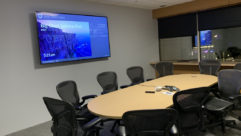
Trends in Courthouse AV
May 17, 2010 12:06 PM,
Provided By InfoComm International
Historically, the legal community isn’t thought of as a technology-savvy group. People usually evoke images of attorneys poring over stacks of books and papers, without an AV device in sight. However, modern-day practitioners of law have adopted AV technologies such as videoconferencing, document cameras, and digital video systems to serve their diverse and dynamic needs.
The General Services Administration (GSA) estimated in 2006 that there are approximately 2,158 federal courtrooms in the United States. That number doesn’t reflect the thousands of state and district courts that also rely on modern AV technology for their proceedings, nor does it reflect the thousands of judges, attorneys, and support staff who rely on AV every day to do their job around the world.
Despite the economy, courthouse budgets have remained strong for several reasons. First, the funding cycle is longer than other markets, such as corporate or houses of worship. Second, some states such as California set aside funds for projects such as courthouse construction and renovation that are protected regardless of the health of the overall state budget.
AV designers and system integrators who service the legal community, and courthouses specifically, are specializing in a niche market. “Because of the things that happen in the courtroom, you must have an understanding about how the judicial process works,” says Kevin Sandler, CEO and president of ExhibitOne, a firm that specializes in courtroom AV technology. “The courtroom participants like technology with strong demonstrative capabilities. AV can be crippling to a courtroom if not done properly.”
The biggest change is that the courts do a great deal more videoconferencing and digital evidence presentation than in years past. Videoconferencing is not the science fiction it was years ago. The technology has improved and the costs have come down,” says Martin Gruen, deputy director of courtroom design and technology for the Center for Legal and Court Technology.
Gruen says that even a small courthouse can afford a LifeSize Passport videoconferencing system, a broadband connection, and a router. “The real question is: Can you afford not to?” he asks.
According to Sandler, the rising popularity of videoconferencing technology is for two reasons: remote arraignment and remote witness testimony. “Remote arraignment is growing quickly at the state level because it saves on transportation cost to and from jail,” he says. “Remote witness testimony is convenient because an expert witness doesn’t have to travel to the courthouse. They go to a local endpoint, which saves time and cost.”
There also is an increase in installations of digital recording systems, with Sandler seeing an even split between video and audio, and audio-only systems. Rather than documenting what is currently happening, court reporters now review those recordings, transcribe them, and construct searchable indexes for future needs.
The use and acceptance of control systems is also on the rise. “Even judges who are hesitant users understand [control systems’] enhancement to the courtroom. Control systems provide a way for the court to control evidence presentation from the bench,” Sandler says.
“Control systems are an absolute necessity, but the program must be a simple, intuitive design. They need one-button control for devices like document cameras. Attorneys are not tech experts,” Gruen says.
Perhaps a large barrier to more digital video adoption is the switch from analog to digital video and the issues it creates. “Changing the aspect ratio from 4:3 to 16:9 seems like an easy switch, but it sometimes alters the presentation of evidence like a handprint. The distorted image can have a psychological effect on the jury,” Gruen says.
In mid-2009, the Center for Legal and Court Technology overhauled the AV in its experimental moot courtroom called Courtroom 21. Gruen refreshed its video systems and upgraded to DVI and other digital platforms over fiber optic. “It was the greatest nightmare of my life,” he says. “We’re finding all kinds of glitches. For example, we’re using an optical switcher, but each time you switch, there is an audible pop. We are a moot courtroom, so if something doesn’t work then that’s okay. But it’s not okay if it’s in a real courtroom. We have an ongoing effort to find the answers.”
Derek Miller, CEO and president of inData, a firm that offers litigation software products and services, notes that the adoption of AV technology is easier today than it was five years ago. “Attorneys are finally seeing the value of keeping the jury’s attention. The information must be entertaining. People want to be involved,” he says.
This is an excerpt from the InfoComm International Special Report Legal Trends in AV. To view the report in its entirety, visit www.infocomm.org.









